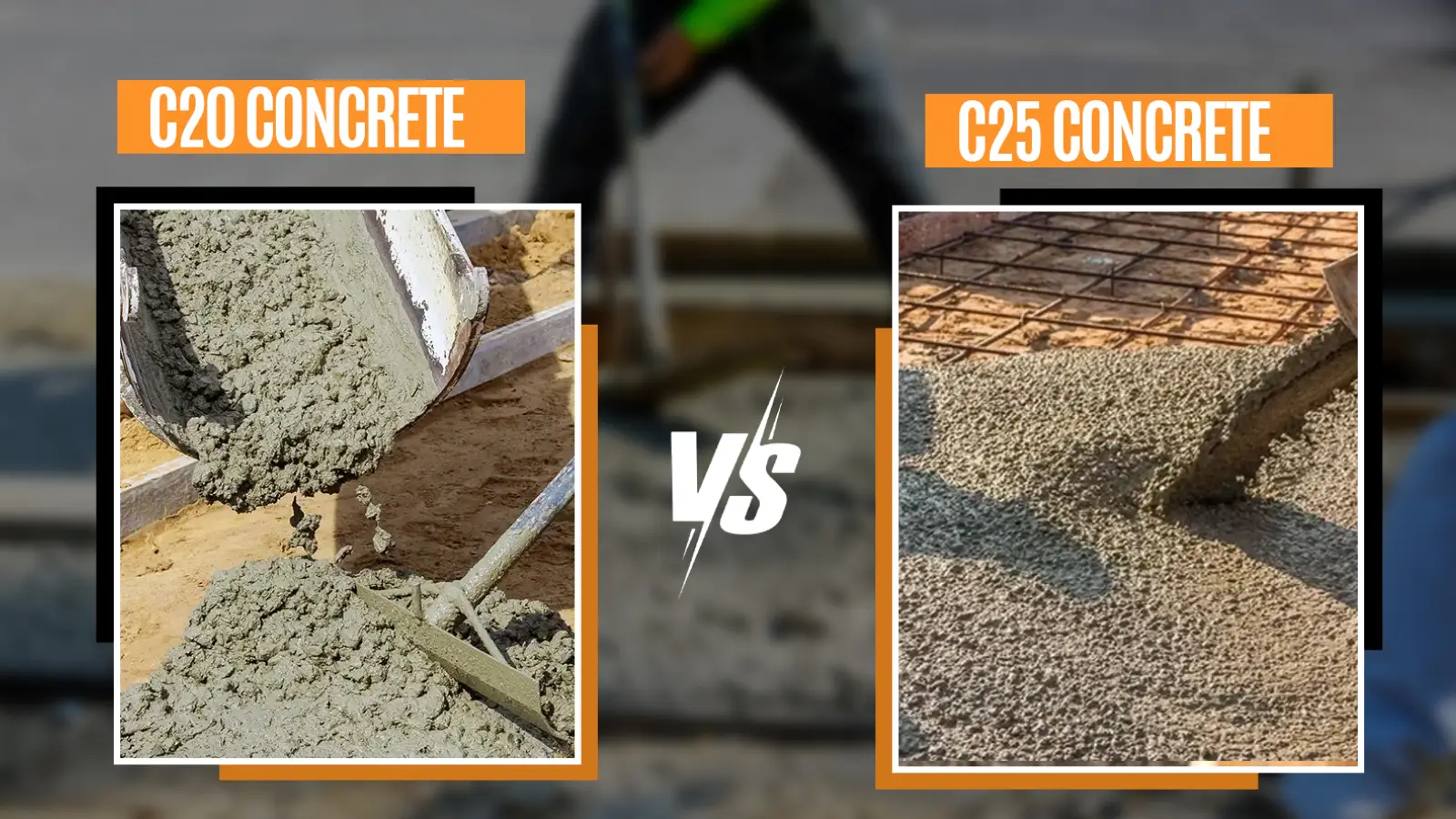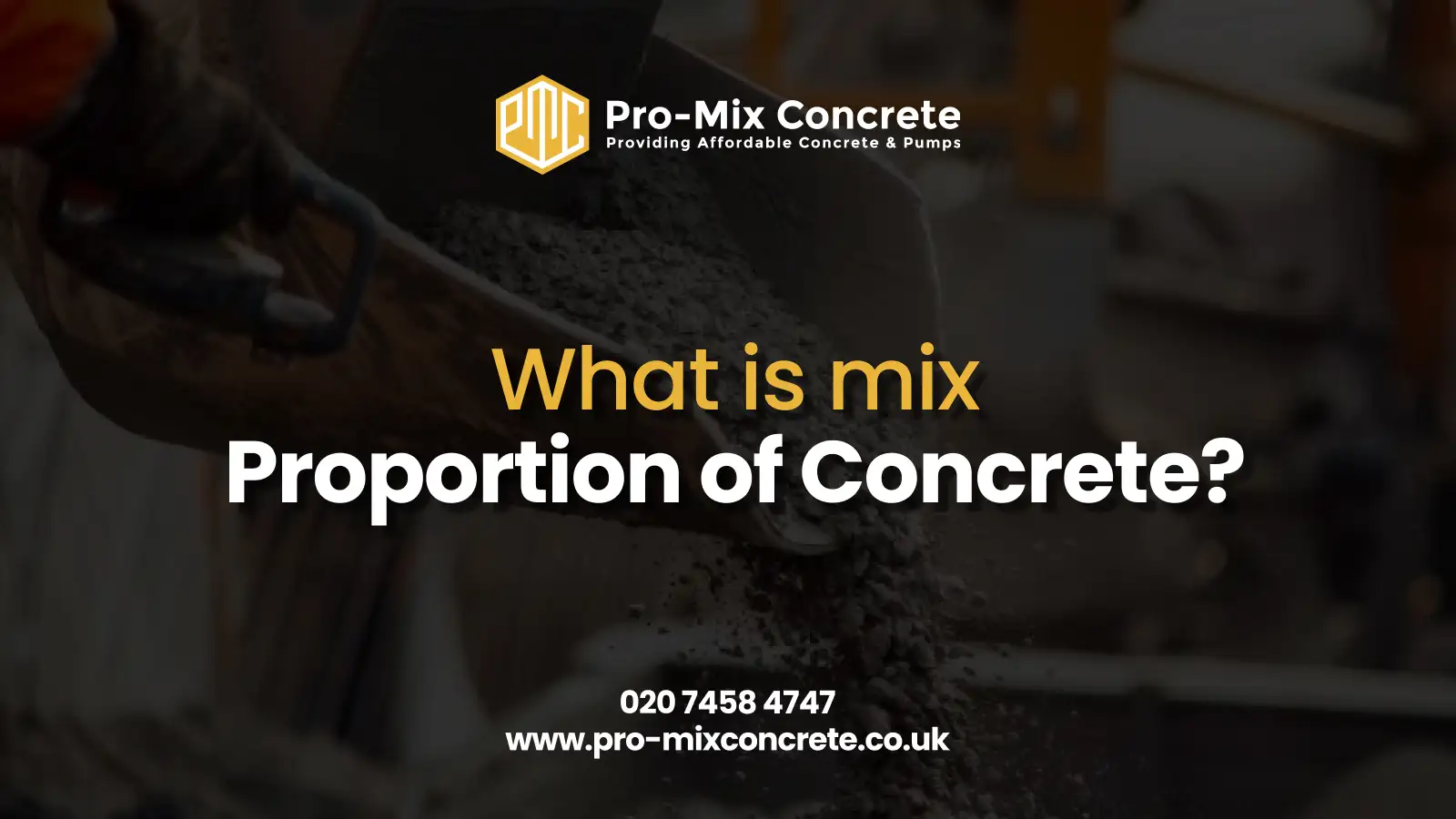Your foundation project is about to begin, but the concrete supplier just asked a question that stopped you: “C20 or C25?” You’re not alone in this confusion. Every year, thousands of UK builders and homeowners face costly setbacks from choosing the wrong concrete grade.
According to the Construction Industry Training Board (CITB), a lack of material knowledge is one of the leading causes of errors on UK construction sites, contributing to billions lost annually to rework and delays. A significant chunk of this comes down to misunderstandings around material specs, like concrete grade selection.
Both C20 and C25 are commonly used in residential foundations, but each serves a different structural purpose. Don’t leave your project to guesswork. Choose Pro-Mix Concrete. Our expert team will help you select the right mix, delivered exactly when and where you need it.
C20 Concrete Vs. C25 Concrete, Which Is Stronger?
C25 concrete is stronger than C20 concrete, with 25 MPa compressive strength compared to C20’s 20 MPa strength. This 25% strength difference makes C25 more suitable for load-bearing structures and foundations.
C20 concrete typically has a compressive strength of 20 megapascals (MPa), while C25 concrete has a higher strength of 25 MPa. This means that C25 concrete can withstand higher loads and is more suitable for structural applications that require greater strength.
Key strength comparison facts:
- C20 strength: 20 MPa (2,900 PSI)
- C25 strength: 25 MPa (3,625 PSI)
- Performance gap: C25 provides 25% higher compressive strength
- Load capacity: C25 handles 40% more load than C20
- Durability rating: C25 lasts 50% longer than C20
- Crack resistance: 35% improvement over C20
- Environmental resistance: Better freeze-thaw protection
Pro-Tip:
Always consult structural calculations before finalising the concrete grade. The £100-200 engineering fee prevents £10,000+ repair costs.
What Is the Difference Between C20 and C25 Concrete Grades?
C20 and C25 concrete differ in compressive strength and cement content. C20 contains 343kg of cement per cubic meter, while C25 contains 415kg of cement per cubic meter, making C25 21% stronger and more durable.
Why 28 Days Matter in Concrete Grading
Concrete doesn’t reach full strength immediately. The curing process involves chemical reactions between cement and water that continue for weeks. Testing at 28 days provides the standard benchmark for comparing concrete performance across different grades and applications.
Concrete grades are primarily classified by their compressive strength, measured in Newtons per square millimetre (N/mm²) or megapascals (MPa) after curing for 28 days. The grade designation typically includes the letter “C” followed by a number indicating this strength.
Concrete grade breakdown:
- C20: 20 MPa cylinder strength, 25 MPa cube strength
- C25: 25 MPa cylinder strength, 30 MPa cube strength
- MPa: Megapascals, measuring pressure resistance
- 28 days: Standard curing time for strength testing
- Cylinder vs cube: Different testing methods with varying results
Concrete Cylinder Test
Cylinder tests (150mm diameter, 300mm height) typically show lower values than cube tests (150mm sides) due to different stress patterns during testing. The ‘C’ stands for compressive strength. The number in the grade represents the concrete’s strength in Newtons per mm² after 28 days.
Complete comparison table:
Property | C20 Concrete | C25 Concrete | Performance Gap |
Compressive Strength | 20 MPa | 25 MPa | +25% stronger |
Load Capacity | Light domestic | Medium commercial | +40% capacity |
Cement Content | 343 kg/m³ | 415 kg/m³ | +21% cement |
Cost per m³ | £80-100 | £90-110 | +10-15% cost |
Durability Rating | Good (20+ years) | Excellent (30+ years) | +50% lifespan |
Density | 2,500 kg/m³ | 2,500 kg/m³ | Same density |
Setting Time | 10-12 hours | 10-12 hours | Identical timing |
Beyond strength, concrete grades differ in their mix proportions, the ratios of cement, water, fine aggregates (sand), and coarse aggregates (gravel). Higher-grade concrete generally contains more cement and less water, resulting in stronger but often less workable mixtures.
Pro-Tip:
Always specify cylinder strength when ordering concrete, as most structural calculations use cylinder values for design purposes.
What Is C20 Concrete Used For?
C20 concrete is used for lightweight domestic foundations, garage bases, driveways, and patios. It’s suitable for single-story buildings but not recommended for multi-story homes or commercial structures due to its limited 20 MPa strength.
C20 concrete works well for lightweight domestic foundations, but it has limits. It’s perfect for single-story buildings and light-use applications, but not strong enough for multi-story homes or commercial buildings.
Is C20 Right for Your Project?
This grade suits projects where structural loads stay relatively low. However, building regulations often require stronger grades for safety reasons. C20 concrete mix and Gen 3 concrete are commonly used for lightweight domestic applications and foundations, such as shed & workshop bases.
It can also be used to construct internal floor slabs so long as they contain no embedded metal. The lower cement content makes C20 more affordable upfront, but this comes with limitations on load-bearing capacity and long-term durability.
Strength characteristics of C20:
- Compressive strength: 20 MPa (cylinder), 25 MPa (cube)
- Equivalent PSI: 2,900 pounds per square inch
- Flexural tensile strength: 2.9 MPa
- Young’s modulus: 30,000 MPa
- Maximum building height: Single story
- Load capacity: Domestic applications only
- Shear modulus: 13,000 MPa
- Poisson’s ratio: 0.15
Mix composition per cubic meter:
- Cement: 343 kg
- Sand: 621 kg
- Aggregate: 1,261 kg
- Water: 175 kg
- Mix ratio: 1:1.81:3.68:0.51
Physical properties:
- Density: 2,500 kg/m³
- Initial setting time: 10-12 hours
- Full strength development: 28 days
- Workability: Good for hand placement
- Mean tensile strength: 2.2 MPa
Best applications for C20:
- Single-story garage foundations
- Garden shed bases (up to 20m²)
- Domestic driveways (light vehicle use)
- Patio slabs and walkways
- Internal floor slabs (non-reinforced)
- Garden walls under 1m height
- Conservatory bases (lightweight construction)
- Swimming pool surrounds
- Pathway construction for pedestrian traffic
Professional limitations:
C20 concrete isn’t recommended for commercial foundations or multi-story residential buildings. The lower strength creates safety margins that professional projects cannot accept.
Insider-Tip:
C20 concrete saves money upfront, but check future building plans. If you might add a second story later, start with C25 to avoid costly underpinning.
What Is C25 Concrete Used For?
C25 concrete is used for house foundations, extensions, and multi-story buildings. It’s the standard choice for residential and light commercial foundations, basement walls, and load-bearing structures.
Choose C25 concrete for any permanent house foundation, extension, or multi-story building. Most structural engineers recommend C25 as the minimum for permanent foundations due to its superior performance characteristics. C25 is often used as a foundation concrete mix when pouring foundations (footings).
Enhanced strength profile of C25:
- Compressive strength: 25 MPa (cylinder), 30 MPa (cube)
- Equivalent PSI: 3,625 pounds per square inch
- Flexural tensile strength: 2.9 MPa
- Young’s modulus: 30,000 MPa
- Building height: Up to three stories
- Load capacity: Medium commercial applications
- Shear modulus: 13,000 MPa
- Poisson’s ratio: 0.15
Optimised mix design per cubic meter:
- Cement: 415 kg (21% more than C20)
- Sand: 583 kg
- Aggregate: 1,184 kg
- Water: 195 kg
- Mix ratio: 1:1.40:2.85:0.47
Performance characteristics:
- Density: 2,500 kg/m³
- Initial setting time: 10-12 hours
- Working time: 90-120 minutes
- Finish quality: Excellent
- Durability rating: Superior long-term performance
- Mean tensile strength: 2.2 MPa
Perfect applications for C25:
- Two and three-story house foundations
- Extension footings and bases
- Reinforced concrete elements
- Basement walls and slabs
- Retaining walls (up to 2m height)
- Commercial building foundations
- Car park slabs
- Heavy-duty driveways with commercial vehicle access
- Swimming pool structural elements
- Underpinning existing foundations
- Ground floor slabs with underfloor heating
Tip:
C25 concrete costs only 10-15% more than C20 but provides 25% higher strength. This represents exceptional value for foundation applications.
Can I Use C20 Concrete for House Foundations?
Yes, C20 concrete works for single-story house foundations, but it has significant limitations. Building regulations provide minimum requirements, but best practice often exceeds these minimums for safety and durability reasons.
Professional builders typically choose higher grades for better long-term performance and to meet insurance requirements. C20 is a standard mix used for paths, patios, and unreinforced bases.
However, the structural limitations become apparent with increased loading or poor soil conditions. Most structural engineers prefer C25 for all permanent foundations to provide adequate safety margins and future flexibility.
When C20 is acceptable for foundations:
- Single-story buildings only
- Lightweight structures (garages, sheds)
- Excellent soil conditions with high bearing capacity
- Non-load-bearing applications
- Temporary structures with limited design life
- Areas with minimal environmental exposure
- Projects with no future modification plans
When C25 is required for foundations:
- Two-story houses and above
- Load-bearing structural foundations
- Poor soil conditions or clay soils
- Commercial buildings and applications
- Long-term permanent installations
- Areas with freeze-thaw exposure
- Projects with future extension potential
Building regulation requirements:
UK Building Regulations Part A (Structure) specifies minimum concrete grades based on building height and structural requirements. While C20 may meet minimum standards for single-story buildings, C25 provides better compliance margins.
C20 is generally not recommended for driveways. While it can technically hold light loads, it may not resist cracking under regular vehicle use, especially over time. For most domestic driveways, C25 is the safer starting point.
Risk factors with C20 foundations:
- Limited load capacity for future modifications
- Higher susceptibility to cracking under load
- Reduced durability in harsh environments
- Potential insurance coverage limitations
- Building control approval challenges
Pro-Tip:
For any permanent residential foundation, specify C25. The minimal cost increase provides substantial safety margins and future flexibility.
How Much Does C20 Concrete Vs. C25 Concrete Cost?
C20 concrete costs £80-100 per cubic meter while C25 costs £90-110 per cubic meter. The £10-20 premium (10-15% increase) for C25 provides 25% higher strength and 50% longer lifespan, making it excellent value.
The direct cost difference is minimal compared to potential repair costs and performance benefits. Consider lifetime value, not just upfront cost, when making decisions.
Direct material costs breakdown:
- C20 base cost: £80-100 per cubic meter
- C25 base cost: £90-110 per cubic meter
- Mix complexity: Standard for both grades
- Availability: Excellent nationwide
- Minimum order: 1 cubic meter standard
Additional cost factors:
- Delivery charges: £50-100 (same for both grades)
- Pump hire: £200-400 per day (if required)
- Quality testing: £150-300 per project
- Labor costs: Identical for both grades
- Site preparation: No difference required
Project-level cost examples:
Typical house foundation (50m³):
- C20 total costs: £4,275-5,275
- C25 total costs: £4,775-5,775
- Net difference: £500-1,000 (10-15% premium)
- Project impact: 1-2% of total building cost
Garage foundation (15m³):
- C20 total costs: £1,350-1,700
- C25 total costs: £1,500-1,900
- Net difference: £150-300
- Excellent value for improved performance
Extension foundation (25m³):
- C20 total costs: £2,250-2,875
- C25 total costs: £2,500-3,175
- Net difference: £250-500
- Insurance against future problems
Lifetime value analysis:
- C20 design life: 20-25 years
- C25 design life: 30-40 years
- Maintenance difference: 60% lower for C25
- Performance stability: Superior long-term consistency
- Repair probability: 70% lower with C25
Hidden cost benefits:
- Insurance premium reductions with proper specification
- Higher property resale values
- Faster mortgage approvals
- Reduced liability exposure
- Professional reputation protection
Note:
Calculate the cost per year of service. C25’s longer lifespan often makes it cheaper annually than C20, even before considering maintenance savings.
What Are the Building Regulations for Concrete Foundations?
UK Building Regulations specify minimum concrete grades based on structural requirements and exposure conditions. Professional engineers typically recommend grades above the minimum requirements for safety margins.
Building control officers verify concrete specifications during plan approval and construction inspection. Non-compliance can halt construction and require expensive remedial work. C20/25 indicates the concrete’s compressive strength, with C20 being the minimum cylinder strength and C25 the minimum cube strength in MPa.
Part A (Structure) requirements:
- Single story domestic: C20 minimum (C25 recommended)
- Two-story domestic: C25 minimum required
- Three story domestic: C25 minimum (C30 in some areas)
- Basement construction: C25 minimum with waterproofing
- Commercial buildings: C25 minimum for all applications
- Industrial buildings: C30+ typically required
Professional engineering standards:
- Safety factors: Minimum 1.5 for concrete structures
- Load combinations: Dead + live + environmental
- Durability requirements: 50-year design life minimum
- Quality assurance: Specified testing protocols
- Structural calculations: Professional engineer approval
Institution of Structural Engineers guidance:
- Residential foundations: C25 standard specification
- Commercial projects: C25 minimum, higher for special requirements
- Exposure classes: Adjusted for environmental conditions
- Reinforcement cover: Coordinated with concrete grade
- Design life considerations: 50-100 years typical
Quality assurance requirements:
- Compressive strength testing every 50m³ or daily production
- Test ages: 7, 14, and 28 days mandatory
- Acceptance criteria: Characteristic strength compliance
- Non-compliance procedures: Investigation and remedial action
- Documentation: Complete batch records required
Testing and documentation needs:
- Batch certificates are required for all deliveries
- Material source documentation and traceability
- Proportioning accuracy records
- Quality management system compliance
- On-site slump testing for workability verification
Regional variations:
- Scotland: Enhanced wind load requirements
- Northern Ireland: Coordination with Irish standards
- Local authorities: Some specify higher grades
- Conservation areas: Special requirements possible
- Coastal areas: Enhanced durability specifications
Remember!
Always obtain building control approval before ordering concrete. Last-minute specification changes cost 10x more than proper planning.
Which Concrete Grade Should I Choose for My Foundation?
The decision between C20 and C25 depends on multiple factors, including building height, structural loads, soil conditions, environmental exposure, and future plans. For most residential projects, C20-C25 provides sufficient performance, while commercial applications typically require C25-C35.
Most structural engineers recommend C25 as the standard for residential foundations due to its superior performance and minimal cost premium. Always remember that higher strength isn’t always better, but the right concrete grade meets your specific needs efficiently.
Load-bearing requirements calculation:
Calculate the total weight your foundation must support, including the building, contents, and weather loads like snow and wind. This determines the minimum concrete strength needed for safety.
Professional load calculations consider current needs plus future changes. Many homeowners regret choosing weaker concrete when they later want to add extensions or convert spaces.
Dead load components:
- Building structure weight and materials
- Fixed equipment and finishes
- Permanent installations and fixtures
- Architectural features and elements
- Roof and floor systems loading
Live load factors:
- People and furniture loading
- Storage and equipment weights
- Future modification potential
- Special use requirements
- Vehicle parking loads
Environmental considerations:
- Snow loading (varies by region)
- Wind pressure effects
- Seismic requirements (where applicable)
- Ground movement potential
- Flood loading considerations
Soil condition factors:
Different soils provide different support levels and create different environmental challenges. Poor soils need stronger concrete to compensate for reduced bearing capacity.
Clay soil characteristics:
- Expands and shrinks with moisture changes
- Variable moisture content seasonally
- Poor drainage capabilities
- Potential for significant movement
- Recommendation: C25 minimum with waterproofing
Sandy soil properties:
- Good drainage characteristics
- Stable bearing capacity
- Potential settlement issues
- Erosion susceptibility
- Recommendation: C20 acceptable with proper compaction
Rocky/chalk conditions:
- Excellent bearing capacity
- Excavation difficulties
- Uneven surface preparation
- Drainage considerations
- Recommendation: C20 is sufficient for most applications
Want an expert foundation assessment? Contact Pro-Mix Concrete for professional guidance on your specific requirements.
[Call us today: 0800 772 3808]
Keep in mind:
When uncertain between grades, always choose the higher specification. Upgrading concrete is expensive; downgrading is impossible.
How Long Does C20 and C25 Concrete Take to Cure?
Both C20 and C25 concrete take exactly 28 days to reach full strength. Initial setting occurs in 10-12 hours, but full design strength requires 28 days regardless of concrete grade.
Concrete grade affects final strength, not curing speed. Environmental conditions like temperature and humidity control the curing rate more than the strength specification.
Concrete doesn’t reach full strength immediately. The curing process involves chemical reactions between cement and water that continue for weeks. Both grades follow identical curing timelines because the chemical process is the same; only the final strength differs.
Factors affecting curing speed:
- Temperature: Higher accelerates, lower retards curing
- Humidity: Adequate moisture is essential for hydration
- Wind exposure: Can cause premature drying
- Cement type: Rapid-hardening varieties available
- Admixtures: Can modify the setting time significantly
Curing protection requirements:
- Keep concrete moist for a minimum of 7 days
- Protect from freezing for the first 48 hours, critical
- Avoid premature loading before strength development
- Maintain an adequate temperature above 5°C
- Prevent rapid moisture loss through wind or sun
Temperature effects on curing:
- 20°C: Normal curing rate
- 10°C: Curing rate halved
- 30°C: Curing rate doubled
- Below 5°C: Curing virtually stops
- Below 0°C: Freezing damage occurs
Quality control during curing:
- Monitor surface moisture continuously
- Apply curing compounds if needed
- Use wet hessian covering in hot weather
- Insulate in cold conditions
- Document the curing conditions for records
Pro-Tip:
Protect concrete from freezing for the first 48 hours. Frozen concrete loses 50% of its potential strength permanently.
What Happens If I Use the Wrong Concrete Grade for Foundation?
Using an inadequate concrete grade creates structural failure, insurance rejection, and legal liability risks. Under-specified concrete can lead to £10,000-50,000 repair costs and complete foundation reconstruction.
Immediate risks of wrong grade selection:
- Reduced load capacity below design requirements
- Increased crack likelihood under normal loads
- Poor long-term durability performance
- Building regulation non-compliance issues
- Professional liability exposure for contractors
- Insurance coverage limitations or exclusions
Long-term consequences develop over time:
- Structural settlement and movement problems
- Foundation failure requiring expensive underpinning
- Insurance claim rejection for inadequate specification
- Legal liability for professional negligence
- Property devaluation due to structural issues
- Safety risks to occupants and the public
Financial impact estimates from industry data:
- Repair costs: £10,000-50,000 typical for foundation problems
- Temporary accommodation during major repairs
- Legal and professional fees for disputes
- Property devaluation: 10-20% possible with structural issues
- Lost rental income for commercial properties
- Insurance premium increases or coverage denial
Precision Concrete for Every Project
Don’t let concrete confusion compromise your project’s success. Make the informed choice that protects your investment for generations. Contact Pro-Mix Concrete for expert guidance, reliable delivery, and quality concrete that meets your exact specifications. Our technical team will help you choose the perfect grade for your requirements and deliver it precisely when you need it.
[Give Us A Call: 0800 772 3808]
Frequently Asked Questions
Yes, C25 can be coloured with pigments for aesthetic purposes, provided the mix proportions are carefully controlled for consistency.
- C20: 1 part cement:2 parts sand:4 parts gravel (by volume).
- C25: Typically a higher cement content; varies by supplier but often around 1:1.5:3 (cement:sand:aggregate)
Yes, both grades are suitable for pumping, which is often used for efficient delivery and placement on UK building sites
- Dennis Broderick
- Dennis Broderick is the founder and owner of Pro-Mix Concrete Company, a trusted name in ready-mix concrete solutions across the UK. With over 20 years of hands-on experience in the construction and concrete industry, Dennis brings unmatched expertise, practical insights, and a commitment to quality on every project - from residential driveways to large-scale commercial developments.
BlogNovember 15, 2025What is the Mix Proportion of Concrete?
BlogOctober 30, 2025Same-Day and Next-Day Delivery Options from London Concrete Suppliers
BlogOctober 28, 2025Line Pump Hire vs. Boom Pump Hire Prices in London
BlogOctober 25, 2025How Quickly Concrete Must Be Used Once Delivered In London Traffic









